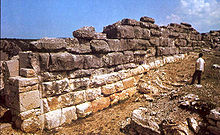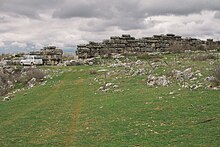 Cyclopean walls of ancient Daorson. Cyclopean walls of ancient Daorson. | |
 | |
| Location | Ošanići, Stolac, Bosnia and Herzegovina |
|---|---|
| Region | Illyria, Dalmatia |
| Type | Megalithic settlement |
| History | |
| Periods | Classical, Hellenistic, Roman |
| Cultures | Illyrian, Roman |
| Site notes | |
| Ownership | Public |
| KONS of Bosnia and Herzegovina | |
| Official name | Archaeological area - the Hellenistic city of Daorson in Ošanići near Stolac |
| Type | Category 0 cultural property |
| Criteria | A, B, C iii.iv.v.vi., D i.iv., F i.iii., G iv., H i., I i.ii.iii. |
| Designated | 21 January 2003 |
| Part of | Stolac, natural and architectural ensemble |
| Reference no. | 605 |
| Decision no. | 01-275/02 |
| Listed | List of National Monuments of Bosnia and Herzegovina |
Daorson (Ancient Greek: Δαορσών) was the capital of the Illyrian tribe of the Daorsi (Ancient Greek Δαόριζοι, Δαούρσιοι; Latin Daorsei). The Daorsi lived in the valley of the Neretva River between 300 BC and 50 BC. They came very early into contact with Greek traders acquiring many facies of Greek civilization, and the town acquired a certain degree of Hellenization. After the peace treaty with Rome in 168/167 BC, the Daorsi minted their own coins.
The ruins of Daorson is located at Ošanići, near Stolac, Bosnia and Herzegovina.
History


Daorson was built around a central fort or acropolis, surrounded by cyclopean walls made of huge stone blocks (similar to those in Mycenae, in Greece). The acropolis would have housed all of the important administrative, public and religious buildings. The defensive wall extending from southwest to northeast was 65 metres long, 4.2 metres wide, and from 4.5 to 7.5 metres high with doors and towers on both sides.
The remnants of numerous wine amphorae have been found, including some ceramic fragments. The most valuable of the finds is a bronze helmet decorated with a series of mythological figures. The inscription on it is similar to the inscription on a helmet found in North Macedonia. The remnants of a granite sculpture of Cadmus and Harmonia have also been found. This piece includes an Illyrian relief with thirteen snakes and five pairs of eagle's wings. A small building housed a mint facility. Thirty-nine different coins were discovered in this building, the majority (29) depicted King Ballaios, who ruled after 168 BC. Money was of immense importance to the Daorsi, allowing the tribe to remain independent while securing their business, cultural and trade links with other groups.
After the Daorsi were attacked by the Delmatae, they joined Issa in seeking the protection of the Roman state. The Daorsi abandoned Caravantius and fought on the side of the Romans, contributing with their strong navy. After the Illyrian Wars the Romans gave the Daorsi immunity.
Site description

Ošanići consist of three linked stones groups, the disposition of which is dictated by the lie of the land.
The central area is occupied by a dominant hill fort or acropolis below and to the south and south-west of which are terraces on the ridge, while to the east, on the Banje plateau, is the outer-acropolis area of residential and commercial, mainly artisanal and trade quarters of the settlement.
The hill fort was built on a prehistoric fortified settlement which had been in existence there since the early (17/16th century BCE) to the end of the late Bronze Age (9/8th century BCE). The date of the ransacking of the town of Daorson that finally put an end to human settlement there can be determined with fair accuracy as the mid or second half of the 1st century BCE from the details of the wars waged by the Roman Praetor Vatinius against the Delmati. No permanent settlement ever arose on the ruins of the town of Daors. There is ample evidence of its advanced culture and civilization: it minted its own coins and produced complex artistically decorated buckles, there is graffiti on shards of pottery vessels, and parts of stone statues of human figures some 2 m in height were found.
A megalithic wall, erected following the lie of the land, has been dated to the 4th century BCE, when both towers were probably built following the construction of the wall. The rest of the acropolis is of later date, through to the 1st century BCE. One of the most important finds is a helmet with the Greek inscription ΠΙИ, probably the abbreviated Illyrian name of the owner PINNES; it was probably made in the 3rd century BCE.
Protection
Daorson is designated National monument of Bosnia and Herzegovina, and, including the nearby Radimlja necropolis, and other individual sites outside the city of Stolac perimeter, is designated as The natural and architectural ensemble of Stolac and proposed for inscription into the UNESCO's World Heritage Site list. The bid for inscription is currently placed on the UNESCO Tentative list.
See also
References
- Henry A. Ormerod, Piracy in the Ancient World, JHU Press, 1924, p. 184.
- The Art treasures of Bosnia and Herzegovina by Đuro Basler, Mirza Filipović, Sulejman Balić, 1987, page 28, "Only to the south of there, in the River Neretva basin, had the influence of Hellenism taken root, principally among the Illyrian Daorsi who occupied..."
- Grčki utjecaj na istočnoj obali Jadrana: zbornik radova sa znanstvenog skupa održanog 24. do 26. rujna 1998. godine u Splitu by Nenad Cambi,ISBN 9531631549,2002,page 432,"and the 3rd century BC when some of the indigenous tribes were fully hellenized..."
- Institute of Archaeology bulletin by University of London. Institute of Archaeology - 1978, page 21.
- Dalmatia: research in the Roman province 1970–2001: papers in honour of J. J. Wilkes by David Davison, Vincent L. Gaffney, Emilio Marin, 2006, page 21, "completely Hellenised town."
- Stipčević 1977, p. 110: "In many ways they imitated the urban Greek life style, and some scholars refer to this Ošanić gradina as a “completely Hellenized town" ( Z . Marić ), which obviously is an exaggeration, though one having some justification. When speaking about central Dalmatia, one cannot quote any similar case of Hellenization."
- Lippert & Matzinger 2021, p. 105.
- "Regional Programme on Cultural and Natural Heritage in South East Europe". Culture and Cultural Heritage. Retrieved 21 September 2018.
- "Ljubljana Process: rehabilitating our common heritage". Culture and Cultural Heritage. Retrieved 21 September 2018.
- Hazim Begagić. "CHAPTER 2 – HERITAGE POLICY IN BiH AND BENEFITS FROM THE LJUBLJANA PROCESS - Heritage for development in South-East Europe". Council of Europe Publishing. Retrieved 21 September 2018.
- Šašel Kos & Kos 2013: "Ošanići"
- Urbano biće Bosne i Hercegovine - page 27 by Seka Brkljača - 1996, "Its name was Daorson. It belonged to the illyrian sphere. Its 46 meters of the old fortress are preserved."
- Wilkes 1992, p. 177: "Two other coinages of Illyrian peoples are dated to the period following 168 BC. Those with the legend DAORSON with a galley on the reverse were produced by the Daorsi."
- Dragićević, I. Daorsi coins and a contribution to the understanding of the circulation of coinage in Daorsi territory 2016, 107–128,
- I greci in Adriatico, Volume 2 by Lorenzo Braccesi, Mario Luni, page 152, "The Daorsi suffered directly from the attacks of the Delmatae and were understandably one of the first peoples who had left Genthius half brother Caravantius and sought protection from the Roman state placing their armed forces at the disposal of the Romans. After the war they were rewarded by having been given immunity..."
- The magistrates of the Roman Republic - by Thomas Robert Shannon Broughton - 1960 - page 446, "Head of a commission sent, after the receipt of complaints from Issa and the Daorsi, to observe conditions in Illyria and Dalmatia."
- "UNESCO World Heritage Centre – Tentative Lists: Bosnia and Herzegovina". UNESCO World Heritage Centre. Archived from the original on 16 July 2017. Retrieved 25 July 2017.
Bibliography
- Lippert, Andreas; Matzinger, Joachim (2021). Die Illyrer: Geschichte, Archäologie und Sprache. Kohlhammer Verlag. ISBN 9783170377103.
- Šašel Kos, M.; Kos, P. (2013). "Places: 197421 (Ošanići)". Pleiades. Retrieved 12 November 2020.
- Stipčević, Aleksandar (1977), The Illyrians: History and Culture, Noyes Press, ISBN 978-0-8155-5052-5
- Wilkes, John J. (1992). The Illyrians. Oxford, United Kingdom: Blackwell Publishing. ISBN 0-631-19807-5.
External links
Categories:- Ancient Bosnia and Herzegovina
- Ancient tribes in Bosnia and Herzegovina
- Illyrian archeological sites and structures in Bosnia and Herzegovina
- Illyrian Bosnia and Herzegovina
- Archaeology of Illyria
- Illyrian architecture
- Illyrian art
- Cities in ancient Illyria
- National Monuments of Bosnia and Herzegovina
- Former populated places in the Balkans
- World Heritage Tentative List for Bosnia and Herzegovina
- Megalithic monuments in Europe